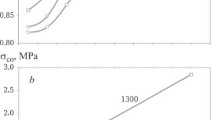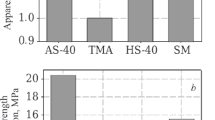ThSe structure and properties of newly developed high-alumina articles based on aluminum silicate fiber are shown. The application of the new NK-29 articles in the lining of high-temperature heat assemblies used in the ceramic industry is examined.
Similar content being viewed by others
Explore related subjects
Discover the latest articles, news and stories from top researchers in related subjects.Avoid common mistakes on your manuscript.
Heat insulation materials are quite widely used in the lining of industrial heating assemblies. Commercial heat insulation articles have low and stable thermal conductivity, adequate mechanical strength, the required refractoriness, and stable properties at high temperatures [1, 2]. The KT-1,1 and KT-1,3 corundum heat insulation articles (GOST 5040–2015) operate at the highest temperatures [3].
It should be noted that corundum articles, like other cellular heat insulation articles, are lightweight and are not characterized by high heat resistance. However, this index is important for periodic heating assemblies. The refractory lining of such heating assemblies is subjected to alternate heating and cooling during operation. As a result a temperature differential arises between the surface and the interior volume of the material, and this can result in failure of the article.
It is known that the heat resistance of composite materials can be increased substantially by introducing fiber materials into grainy ceramic articles. Such articles are much more resistant to thermal shock than cellular ceramics. It is also known that fibers can form two types of compositions [4]:
-
pore-free: the fibers reinforce the inorganic matrix;
-
high-porosity: an inorganic porosity-decreasing binder strengthens the fibers and lowers the thermal resistance of the fibrous material by a very small amount.
A technology for manufacturing NK-29 heat resistant articles on the basis of fibers strengthened by inorganic binder has been developed by PKF NK, JSC [5]. The developed articles comprise a fired porous material consisting of randomly arranged Al2O3–SiO2 fibers, a lightweight filler material, and an inorganic binder. The microstructure of these articles is shown in Fig. 1.
The main crystalline compounds of the article are corundum (3.48, 2.55, 2.085, and 1.601 Å), mullite (5.39, 3.43, 3.39, and 2.54 Å), and α-cristobalite (4.11 and 2.52 Å). A distinguishing feature of the obtained material is high ultimate strength in compression, equal to at least 7.0 MPa. The maximum service temperature equals 1500°C.
Physical-Chemical Properties of NK-29 Heat Insulation
Article . . . . . . . . . . . . . . . . . . . . . . . . NK-29 |
Mass fraction, %: |
Al2O3, not less than. . . . . . . . . . . . . . . . . . . 63 |
Fe2O3, not more than. . . . . . . . . . . . . . . . . . 1.0 |
Apparent density, g/cm3, not more than . . . . . . . . 1.35 |
Residual dimensional changes on heating up to 1500°C, %, not more than . . . . . . . . . . . . . 1.0 |
Ultimate strength in compression, N/mm2, not less than . . . . . . . . . . . . . . . . . . . . . . . 7.0 |
Thermal conductivity at average temperature 650 ± 25°C, W/(m·K), not more than . . . . . . . . . 0.45 |
Maximum service temperature, °C. . . . . . . . . . . 1500 |
For comparative evaluation heat-resistance testing of NK-29 and corundum lightweight refractory was conducted according to GOST 5040–2015. The tests were conducted in air at 1300°C. Investigations showed the heat resistance of the NK-29 developed material to be many-fold higher compared with KT-1,1 and KT-1,3 materials.
It was shown that the NK-29 articles consist of high-alumina porous filler bonded by aluminum silicate fibers which are in contact at individual points with one another and with the filler grains. The presence of fibers in the refractory makes it resistant to sharp temperature fluctuations.
In addition, owing to such structure the fraction of the heat flux transferred by conduction along fibers and the filler in the indicated articles is low. This is a consequence of the high thermal resistance of the point contacts formed in this matter [4]. The thermal conductivity of the NK-29 articles does not exceed 0.45 W/(m·K) at average temperature 650°C (the thermal conductivity of KT-1,3 does not exceed 0.80 W/(m·K)).
It is well-known that the existing methods of determining the heat resistance do not fully reflect the actual sharp temperature impacts on refractory articles during service. They are suitable for comparative evaluation of the heat resistance of articles. In practice it is necessary to know the actual damage caused by sharp heating or cooling of a refractory article. For this reason visual inspection of the lining during service was conducted in order to determine the stability of the articles made of NK-29 material in periodic operating regimes of a furnace.
The observations were conducted on a periodic furnace, lined with the NK-29 heat insulation material, at PKF NK, JSC. The furnace is shown in Fig. 2 (designed by Teplokhimmontazh, JSC). The maximum working temperature was 1470°C. This furnace is used mainly for firing refractory ceramic. The articles made of the NK-29 material were used in the lining in the walls and roof of the furnace. The articles functioned for more than seven years up to major overhaul. It should be added that the absence of dense refractories in the construction of this periodic furnace substantially decreases the thickness of the lining and the accumulation of heat in the masonry.
It is known that the crystallization occurring in glassy fibers upon heating restricts the temperature interval of service of conventional articles based on them. For example, according to GOST 23619–79 the maximum temperature range of fibrous articles produced in accordance with the indicated standard is 1150 – 1300°C [6]. The NK-29 articles operate successfully at 1470°C in spite of the crystallization of the fibers occurring upon firing of these articles. In addition, in the current year a second periodic furnace with a similar design was put into operation at the enterprise.
NK-29 articles have exhibited high service properties in the working layer of the periodic furnace at Rechitskii farforovyi zavod, JSC [Rechitsa Porcelain Plant] (Fig. 3). The furnace was built according to a design developed by Teplokhimmontazh, JSC (Staryi Oskol).
NK-29 articles have also been used to repair a slotted roller furnace in the ceramic tile shop at OSMiBT, JSC (Fig. 4). For this articles with different configuration were fabricated (roof brick, side brick with openings for rollers, block for protecting metal structures, and others). These refractory articles were substituted for imported articles manufactured by the firm Thermal Ceramics. The customer did not find any faults during operation of the furnace after the imported refractories were replaced.
In summary, the developed NK-29 articles showed successful operation in continuous and periodic heating assemblies and can be recommended for furnace lining in the ceramic industry.
References
J. Allenshtein, et al., Handbook of Refractory Materials: Structure, Properties, Testing [Russian translation], Intermet Inzhiniring, Moscow (2010).
K. K. Strelov, I. D. Kashcheev, and P. S. Mamykin, Technology of Refractories [in Russian], Metallurgiya, Moscow (1988).
GOST 5040–2015: Refractory Heat Insulating Articles. Technical Specifications [in Russian], Standartinform, Moscow (2016).
S. M. Kats, High Temperature Heat Insulating Materials [in Russian], Metallurgiya, Moscow (1981).
R. V. Zubashchenko, “Heat insulating articles at PKF NK, JSC,” Novye Ogneup., No. 7, 19 – 21 (2013).
GOST 23619–79: Materials and Articles — Refractory Heat Insulation Mullite-Silica Glass-Fiber, Technical Specifications [in Russian], Izd. standartov, Moscow (2004).
Author information
Authors and Affiliations
Corresponding author
Additional information
Translated from Steklo i Keramika, No. 6, pp. 21 – 23, June, 2017.
Rights and permissions
About this article
Cite this article
Zubashchenko, R.V. Experience in Using Aluminum-Silicate Fiber Based Heat-Resistant Thermal Insulation in Heating Assembly Linings in the Ceramic Industry. Glass Ceram 74, 209–211 (2017). https://doi.org/10.1007/s10717-017-9963-7
Published:
Issue Date:
DOI: https://doi.org/10.1007/s10717-017-9963-7








